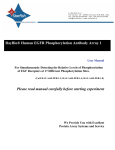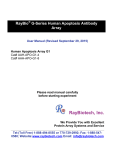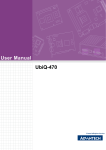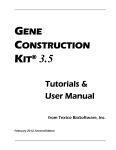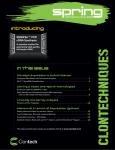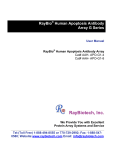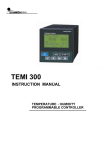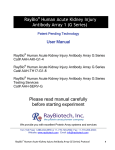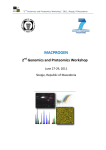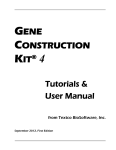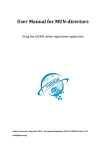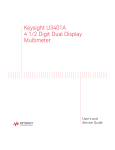Download Manual - RayBiotech, Inc.
Transcript
RayBio® C-Series Human Heat Shock Protein Antibody Array User Manual Cat# AAH-HSP-1-2 AAH-HSP-1-4 AAH-HSP-1-8 For Simultaneous Detection of the Relative Levels of 9 Heat shock protein Markers Version 1.0 August 31, 2013 Please read manual carefully before starting experiment RayBiotech, Inc. We Provide You with Excellent Protein Array Systems and Service Tel (Toll Free): 1-888-494-8555 or 770-729-2992; Fax: 1-888-547-0580 Website: www.raybiotech.com; Email: [email protected] RayBiotech, Inc. RayBio® Human Heat Shock Protein Antibody Array Kit TABLE OF CONTENTS I. Introduction……..……………………………… 2 II. Principle of the Assay……………………… … 3 III. Kit Components & Storage………………… 5 IV. Reagent Preparation………………………… 6 V. Overview and General Considerations… 7 a. Preparation of Samples………………….. 7 b. Handling Array Membranes……………… 8 c. Incubation……………………………………… 8 VI. Protocol……………………………………………… 8 a. Blocking and Incubation………………… 8 b. Detection……………………………………… 10 VII. Interpretation of Results……………………. 11 VIII. Array Map…………………………………………… 12 IX. Troubleshooting Guide……………………… ® RayBio Human Heat Shock Protein Antibody Array Kit 1 14 I. Introduction Heat shock proteins (HSP) are a family of functionally related molecular chaperones, which play critical roles in protein folding, intracellular trafficking of proteins, and coping with proteins denatured by heat shock and other stresses. HSPs are found in virtually all living organisms, from bacteria to humans. HSP family includes 5 major classes according to their molecular weights, i.e., the small heat-shock proteins (sHSPs), HSP33, HSP60, HSP70 and HSP90/ HSP100. The smaller 8-kD protein ubiquitin, which marks proteins for degradation and is regarded as co-chaperone, also belongs to HSP family. In addition to their roles in protein trafficking and and stress response, HSPs are also important in cardiovascular functions and modulation of immune responses. Some HSPs have been under investigation as therapeutic targets in cancer. ® RayBio Human Heat Shock Protein Antibody Array Kit 2 II. Principle of the Assay With the RayBio® Heat Shock Protein Antibody Array kit, researchers can now simultaneously detect the relative level of 9 HSP related proteins in cell lysates. By monitoring the changes in protein levels in different experimental model systems, researchers can study pathway activation without spending excess time and effort in performing immunoprecipitations and/or Western Blotting. Each array membrane is pre-printed with capture antibodies; treated or untreated cell lysate is then added to each membrane. After extensive washing, the membranes are incubated with a cocktail of biotin-conjugated anti-apoptotic protein antibodies. After incubation with HRP-Streptavidin, the signals are visualized by chemiluminescence. ® RayBio Human Heat Shock Protein Antibody Array Kit 3 How It Works + Sample Antibody array chips Incubation of Sample with antibody array chips Overnight Cocktail of biotinconjugated antiHSP marker 2 hrs Incubation with cocktail of biotin-conjugated antiHSP marker LabeledStreptavidin Incubation with labeled Streptavidin Data analysis ® RayBio Human Heat Shock Protein Antibody Array Kit 4 2 hrs III. Kit Components & Storage Store entire kit at ≤ -20 °C immediately upon arrival. Kit must used within the 6 month expiration date. ITEM COMPONENT 2 SAMPLE KIT 4 SAMPLE KIT 1 2 8 SAMPLE KIT Human HSP Array C1* 2 membranes 4 membranes 8 membranes Blocking Buffer 1 vial (25 ml) 1 vial (25 ml) 2 vials (25 ml/ea) Detection Antibody 3 1 vial 2 vials 4 vials Cocktail 1,000X HRP-Streptavidin 4 1 vial (50 µl) Concentrate 20X Wash Buffer I 5 1 vial (10 ml) 1 vial (10 ml) 1 vial (20 ml) Concentrate 20X Wash Buffer II 6 1 vial (10 ml) 1 vial (10 ml) 1 vial (20 ml) Concentrate 2X Cell Lysis Buffer 7 1 vial (5 ml) Concentrate 8 Detection Buffer C 1 vial (1.5 ml) 1 vial (1.5 ml) 1 vial (2.5 ml) 9 Detection Buffer D 1 vial (1.5 ml) 1 vial (1.5 ml) 1 vial (2.5 ml) Protease Inhibitor 1 vial 1 vial 2 vials Cocktail 8-Well Incubation Tray 10 1 tray w/ Lid 11 Plastic Sheets 4 sheets 12 Array Map Template 1 template 13 User Manual 1 booklet * Each plastic package contains 2 or 4 membranes. **For up to 3 months (unless stated otherwise) or until expiration date. STORAGE TEMPERATURE AFTER THAWING** ≤ -20 °C 2-8 °C (up to 3 days after dilution) 2-8 °C ≤ -20 °C Room Temperature Additional Materials Required • • • • • • Pipettors, pipet tips and other common lab consumables Orbital shaker or oscillating rocker Tissue Paper, Blotting Paper or Chromatography Paper Adhesive Tape or Plastic Wrap Distilled or De-ionized Water Chemiluminescent blot documentation system (CCD Camera, X-Ray Film and a suitable film processor, Gel documentation system, or other chemiluminescent detection system capable of imaging a Western blot) ® RayBio Human Heat Shock Protein Antibody Array Kit 5 IV. Reagent Preparation 1. 1X Cell Lysis Buffer: 2x Cell lysis buffer should be diluted 2-fold with deionized or distilled water before use. Note: Proceed to 2. before completing the rest of the 2X Cell Lysis Buffer preperation. Add 20 µl of prepared 100X Protease Inhibitor Cocktail Concentrate (bring the tube to room temperature to thaw the solution before use) into 1.98 ml 1X Lysis Buffer before use. Mix well. 2. Protease Inhibitor Cocktail: Briefly spin down the Protease Inhibitor Cocktail tube before use. Add 60 µl of 1X Lysis Buffer into the vial to prepare a 100X Protease Inhibitor Cocktail Concentrate. Note: Be sure to complete 2X Cell Lysis Buffer preparation before proceeding to 3. 3. 20X Wash Buffer I or II: If the Wash Buffer Concentrate (20X) contains visible crystals, warm to room temperature and mix gently until dissolved. Dilute 20 ml of Wash Buffer Concentrate into 380 ml of deionized or distilled water to yield 400 ml of 1X Wash Buffer. 4. Detection Antibody Cocktail: Briefly spin the vial before use. Add 150 µl of Blocking Buffer to the tube. Mix gently and transfer the entire mixture to a tube containing 1.80 ml of Blocking Buffer to prepare 1X Cocktail of Biotin-Conjugated Antibody Mix. 5. 1000X HRP-Conjugated Streptavidin: briefly spin down the HRP Streptavidin Concentrate to remove any liquid from the vial cap and pipette up and down to mix gently before use. Prepare 1X HRPConjugated Streptavidin. Example: add 5 µl of HRP-Conjugated Streptavidin concentrate into a tube with 4.995 ml Blocking Buffer and ® RayBio Human Heat Shock Protein Antibody Array Kit 6 mix gently. Use immediately, do not store the 1X Streptavidin for next day use. Note: mix tube containing 1,000X HRP-Conjugated Streptavidin well before use since precipitation may form during storage. V. Overview and General Considerations A. Preparation of Samples Remove supernatant from cell culture for attached cells, wash cells twice with cold 1X PBS (for suspension cells, pellet the cells by spinning down the cells at 1500 rpm for 10 min) making sure to remove any remaining PBS before adding Lysis Buffer. Solubilize the cells at 2x107 cells/ml in 1X Lysis Buffer containing Protease Inhibitor Cocktail (prepared in step 1 of Reagent Preparation). Pipette up and down to resuspend cells and rock the lysates gently at 2–8 °C for 30 minutes. Transfer extracts to microfuge tubes and centrifuge at 14,000 x g for 10 min. It is recommended that sample protein concentrations be determined using a total protein assay such as the BCA Assay. Before applying to the membranes, all lysates should be diluted at least 5-fold with 1X Blocking Buffer. For the RayBio® Human Heat Shock Protein Antibody Array Kit, 200 µg/ml to 600 µg/ml of total protein from cell lysates (after dilution with Blocking Buffer) should be used for incubation. Lysates should be used immediately or aliquotted and stored at -80 °C. Thawed lysates should be kept on ice prior to use. Note: If you experience high background, you may further dilute your samples. ® RayBio Human Heat Shock Protein Antibody Array Kit 7 B. Handling Array Membranes • Always use forceps to handle membranes, and grip the membranes by the edges only. Flat-tipped forceps are best for handling membranes. • Never allow array membranes to dry during experiments. • Avoid touching array membrane by hand, tips or any sharp tools. C. Incubation • Completely cover membranes with sample or buffer during incubation, and cover eight-well tray with lid to avoid drying. • Avoid bubbles and foaming during incubation steps. • Perform all incubation and wash steps under gentle shaking (1-2 cycles/sec). • The following incubations may be done overnight at 4°C: all wash steps, Step 3 (sample incubation), Step 7 (biotin-Ab incubation) and Step 10 (HRP-streptavidin incubation). VI. Protocol A. Blocking and Incubation 1. Place each membrane into the provided 8-well tray (top left corner marked with “-”). Note: The printed side should be facing upward. 2. Add 1 ml Blocking Buffer and incubate at room temperature with gentle shaking for 30 minutes to block membranes. 3. Decant Blocking Buffer from each well. Add 1 ml diluted sample onto each array membrane, and cover with the lid. Incubate at 2 – 8 0C ® RayBio Human Heat Shock Protein Antibody Array Kit 8 overnight on a rocker or shaker (low speed 1-2 cycles/sec). Dilute sample using Blocking Buffer. Note: 1) Dilute cell lysates at least 5-fold with Blocking Buffer to avoid high background. Note: 2) Optimal sample dilution factors should be determined empirically. More sample can be used if signals are too weak. If signals are too strong, the sample can be diluted further. Note: 3) Incubation may be done at room temperature for 4 hours, but this may cause lower signals. 4. Decant the samples from each well, and wash 3 times with 1.5 ml of 1X Wash Buffer I at room temperature with shaking, 5 min per wash. 5. Wash 2 times with 1.5 ml of 1X Wash Buffer II at room temperature with shaking, 5 min per wash. 6. Carefully remove wash buffer from each well containing array membranes. 7. Add 1 ml of diluted Cocktail of Biotin-Conjugated Antibody Mix to each membrane. Incubate at 2 – 8 0C with gentle shaking overnight. Note: Incubation may be done at room temperature for 2 hours. 8. Wash as directed in steps 4, 5 and 6. 9. Add 1.5 ml of 1X HRP-conjugated Streptavidin to each membrane. 10. Incubate HRP-streptavidin at room temperature for 1.5 hours. Note: incubation may be done overnight at 40C. ® RayBio Human Heat Shock Protein Antibody Array Kit 9 11. Wash as directed in steps 5 and 6. B. Detection NOTE: Do not let the membrane dry out during detection. The detection process must be completed within 40 minutes without stopping. 1. Proceed with detection reaction. Add 250 µl of Detection Buffer C and 250 µl of Detection Buffer D for one membrane; mix both solutions; Drain off excess wash buffer by holding the membrane vertically with forceps. Place membrane protein side up (“-” mark is on the protein side top left corner) on a clean plastic sheet (provided in the kit). Pipette the mixed Detection Buffer on to the membrane and incubate at room temperature with gentle shaking for 2 minutes. Ensure that the detection mixture is completely and evenly covering the membrane without any air bubbles. 2. Drain off excess detection reagent by holding the membrane vertically with forceps and touching the edge against a tissue. Gently place the membrane, protein side up, on a piece of plastic sheet (“-” mark is on the protein side top left corner). Cover the array with another piece of plastic sheet. Gently smooth out any air bubbles. Avoid using pressure on the membrane. 3. Detect signal directly from membrane using chemiluminescence imaging system or expose to x-ray film (we recommend Kodak XOmat™ AR film) to detect signal using film developer. Expose the membranes for 40 Seconds. Then re-expose the film according to the intensity of signals. If the signals are too strong (background too high), reduce exposure time (e.g., 5–30 seconds). If the signals are too weak, increase exposure time (eg, 2–20 min or overnight). Or re-incubate ® RayBio Human Heat Shock Protein Antibody Array Kit 10 membranes overnight with 1X HRP-conjugated Streptavidin, and repeat detection on the second day. 4. Save membranes at –20 °C to –80 °C for future reference. VII. Interpretation of Results Membrane signals are normally detected by a chemiluminescene imaging device. Membranes also can be exposed to Kodak X-Omat™ film at room temperature. A biotinylated protein provides positive signals, which can be used to identify the orientation and to normalize the results from different wells being compared. By comparing the signal intensities, relative expression levels of target proteins can be made. The intensities of signals can be quantified by densitometry. The positive controls can be used to normalize the results from different membranes being compared. Antibody affinity to its target varies significantly between antibodies. The intensity detected on the array with each antibody depends on this affinity; therefore, signal intensity comparison can be performed only within the same antibody/antigen system and not between different antibodies. One important parameter is the baseline signal response. To obtain the best results, we suggest that several exposures be attempted. We also strongly recommend using a negative control in which the sample is replaced with an appropriate mock buffer according to the array protocol, particularly during your first experiment. ® RayBio Human Heat Shock Protein Antibody Array Kit 11 VIII. Human Heat Shock Protein Antibody Array Map POSA NEG HSP90 GRP75 HSP27 HSP32 UBIQ HSP40 HSP60 HSP70 HSP10 NEG NEG POSA X. Representative Data using Human Heat Shock Protein Antibody Array ® RayBio Human Heat Shock Protein Antibody Array Kit 12 IX. Troubleshooting Guide Problem Weak or no signal Cause Recommendation Taking too much time for detection Entire detection process must be completed in 30 minutes Film developer does not work properly Fix film developer Did not mix HRP-streptavidin well before use Mix tube containing HRP-streptavidin well before use since precipitates may form during storage. Sample is too dilute Increase sample concentration Reduce blocking concentration by diluting in 1X Wash Buffer II Slightly increase HRP concentration Other Slightly increase biotin-antibody concentration Expose film overnight Uneven signal Bubbles formed during incubation Remove bubbles during incubation Membranes were not completely covered by solution Completely cover membranes with solution Exposure to x-ray film is too long Decrease exposure time High background Membranes were allowed to dry Completely cover membranes with out during experiment solution during experiment Sample is too concentrated ® RayBio Human Heat Shock Protein Antibody Array Kit Increase sample dilution 13 RayBiotech, Inc., the protein array pioneer company, strives to research and develop new products to meet demands of the biomedical community. RayBio® patent-pending technology allows detection of over 1000 cytokines, chemokines and other proteins in a single experiment. Our format is simple, sensitive, reliable and cost effective. Products include: Cytokine Arrays, Chemokine Arrays, ELISA kits, EIA kits, Phosphotyrosine kits, Recombinant Proteins, Antibodies, and custom services. This product is for research use only ©2009 RayBiotech, Inc. ® RayBio Human Heat Shock Protein Antibody Array Kit 14
















